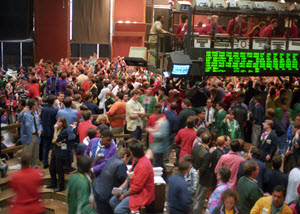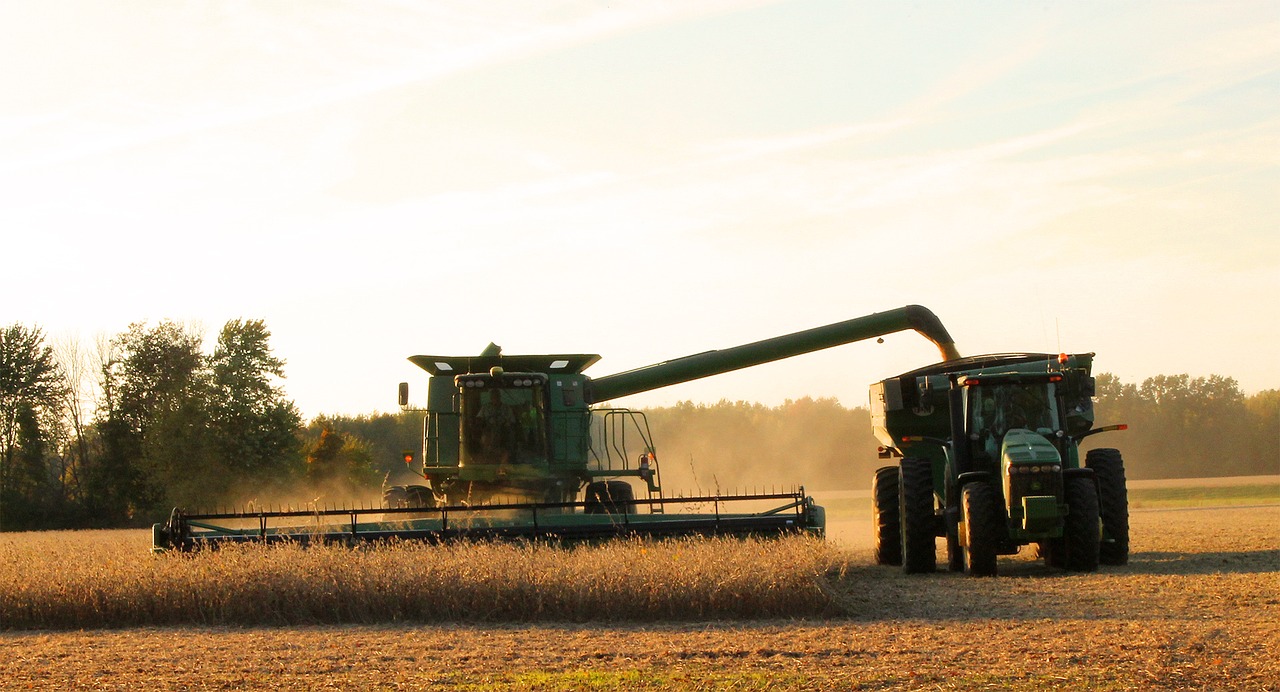THE OPEN
Nov beans: 2 higher
Dec meal: .30 higher
Dec soyoil: 8 lower
Sep. corn: 2 1/2 higher
Sep. wheat: 1 1/2 higher
The markets opened as called with initial selling pressure with grains at recent highs and beans/meal sitting on overall lows. Oilshare was slightly lower as meal pricing increased as prices sat on lows. Though reports of hot and dry forecasts circulated, position-evening remained the key feature into the 11:00 Stocks/Acreage report. The acreage numbers, when released, were bullish for new-crop corn and beans, neutral for wheat, while grain stocks were bearish for grains and neutral for beans. The numbers released created an across-the-board rally.
The June Quarterly Stocks/Acreage had this to say:
DJ USDA Report: Summary for U.S. Quarterly Grain Stocks
Tuesday's USDA USDA
Estimate Average Range June 1 2019 Mar 2020
Corn 5,224 4,990 4,849- 5,405 5,202 7,951
Soybeans 1,386 1,381 1,275- 1,490 1,783 2,255
Wheat 1,044 979 925- 998 1,080 1,415
DJ USDA Report: Summary for June Acreage
Tuesday's USDA USDA
Estimate Average Range March 2019
Corn 92.006 95.205 94.0-96.0 96.990 89.7
Soybeans 83.825 84.764 84.3-85.6 83.510 76.100
All Wheat 44.250 44.707 44.5-45.0 44.655 45.158
Winter Wheat 30.550 30.833 30.7-31.1 30.775 31.159
Spring Wheat 12.200 12.567 12.2-12.9 12.590 12.660
Durum Wheat 1.500 1.330 1.3-1.4 1.290 1.339
Surprises add the largest bang for the buck, and the acreage report was a game-changer for the corn market. The forecast of 92.0 mln acres was under the average trade guess, and at the lowest end of market extremes. The reaction garnered a big response as funds short-covered into commercial hedging. Buy-stops were triggered in grains and soy on the more bullish than expected acreage numbers.
Corn: 92.0 mln is 2 mln more acres than last year, but 5 million fewer than the USDA had projected for this year. Harvested acreage at 84 million acres, up 3% from year ago.
Beans: 83.8 mln acres is up 10% from last year. USDA stated planted acreage for beans is higher or unchanged in 24 of 29 states.
Wheat: wheat acres were down 2% from last year, the lowest all-wheat planted areas since records started in 1919. Winter wheat area is at 30.6 mln, down 2% from year ago. Spring wheat is at 12.2 mln, down 4% from 2019. Durum 2020 is projected at 1.5 mln acres, up 12% from year ago.
SOY
- The soy complex opened on a mixed note with meal gaining on soyoil in the early part of the trading session while bean values remained well supported on breaks. Nearby bean inverses congested as we traded into first notice day without bean deliveries. Sep. crush traded to 75.53c/bu while oilshare traded to 32.64%.
- In political news, China signed the new national security laws for Hong Kong leading the US to revoke Hong Kong's preferential treatment on imports. Nonetheless, beans stayed the course pre-report finding support on pullbacks as prices continued to sit relatively close to trading range lows.
- December soyoil backtracked to test key support at 28c while meal prices attempted to stabilize before the numbers.
- The report, construed as friendly, sent the soy complex out of recent ranges to the upside, triggering nice reversal activity. Though the bean number was not as bullish as corn, prices followed along in a technical trade to run buy-stops over the $8.85 level and into new highs.
- A settlement today over $8.80 would target $8.92-$9.02 Nov beans. Dec meal prices also traded to the top of the trading range as funds are short 40K. December soyoil traded back over 29c following in line with other markets, though today's spike high is more suggestive that this is a good place to get short or take off a long.
GRAINS
- Grains were mixed but took a defensive tone after the open with the corn bounce mostly being technical in nature due to short-covering activity.
- Farmer selling picked up at the open as some appeared ready to price before the data was released.
- Sep/Dec corn traded out to 7c from 5 3/4c before the report. Sep. wheat backed away from multiple chart highs of $4.91 as those not already short elected to put something on at the higher end of the opening trading range.
- After the report, September corn surged over the top of recent highs at $3.39 to hit the 100-day moving average located at $3.45. December corn traded out recent tops at $3.48 to move above its 100-day moving average at $3.54 as short-covering escalated. Post report spreads were wider with Sep/Dec corn moving out to 9c from 5 1/2c. Sep. wheat reaction was to trade over key resistance at $4.94 which triggered buy-stops and a move towards $5.00. However, this market rally was not as healthy as the others, as $5.00 appeared as stiff resistance. Corn continued to gain on wheat, with the Sep. spread moving from 1.58 1/2c down to 1.52 1/2c.
AT 12:00 THE MARKETS ARE AS FOLLOWS:
HI LO
November beans: 23 higher 8.87 8.59 1/2
December meal: 4.80 higher 295.60 288.20
December soyoil: 55 higher 2919 2817
Sep. corn: 12 higher 3.45 3/4 3.26
Sep. wheat: 7 higher 4.98 3/4 4.81 1/4
Nov canola: 4.70 higher 479.80 472.70
OUTSIDE MARKETS
The Dow opened 50 pts lower but turned higher by midday as the S&P 500 has one of the best quarters since 1998. Crude oil trades to $38.85/barrel with the US dollar lower at 97.23.
CLOSING COMMENTS
The report was a game-changer (corn), as charts and prices will now have to adjust. For now, it appears as though the March 31 Planting Intentions report will be the highest acreage number for the year for corn. Producers were holding out for higher prices, and that patience will be rewarded today. The size of the corn crop now increases the need for weather to remain ideal heading into July. So far, so good.
What does this mean technically for prices? For corn, it temporarily solidifies the lower end of the trading range until the crops are made. Open interest tonight will be important to see if new shorts were added or whether open interest had to come out. A good close over $8.80 Nov beans implies that a target high of $8.92 could be hit. Sep. corn prices hit the 100-day moving average at $3.46, while the lower end of the Sep. corn market may have moved up to $3.25 from $3.15 temporarily, given the new acreage number. A close above the 100-day moving average of $3.45 could send prices up to $3.55. Sep. wheat could find its way back to $5.15 and Dec. soyoil at 2950c if settlements remain constructive today. Given the new statistics and hotter/drier weather next week, look for prices to remain solidly in the plus column.
The settlements today are extremely important, and the gains are enough that pullbacks will now probably hold heading into the July 4 weekend. It's a short week, so would expect more corn bears to look for a place to lighten up.
TAGS – Feed Grains, North America

 Friday’s strength in CBOT and broader global ag commodity futures was simply a foreshadowing of the rallies that would develop on Monday. Heading into the weekend, markets were jittery on perceived weather risks, many of which turned out to be prescient. Over the weekend, parts of the U.S...
Friday’s strength in CBOT and broader global ag commodity futures was simply a foreshadowing of the rallies that would develop on Monday. Heading into the weekend, markets were jittery on perceived weather risks, many of which turned out to be prescient. Over the weekend, parts of the U.S...
 Update for 1 April 2024: Last year, users pointed out differences between the 5-year averages reported in this app and what USDA estimates in its weekly report. The difference exists because WPI calculates average based on the last 5 years of observations for the current week. In cases where ob...
Update for 1 April 2024: Last year, users pointed out differences between the 5-year averages reported in this app and what USDA estimates in its weekly report. The difference exists because WPI calculates average based on the last 5 years of observations for the current week. In cases where ob...
 Trading Waste Rich Westerners consumed so much plastic that even though landfills take much of it, their export of plastic waste now overwhelms Asia. Then Western policymakers gave yellow grease (used cooking oil) a very low carbon score for use as energy since it is a form of recycling. With h...
Trading Waste Rich Westerners consumed so much plastic that even though landfills take much of it, their export of plastic waste now overwhelms Asia. Then Western policymakers gave yellow grease (used cooking oil) a very low carbon score for use as energy since it is a form of recycling. With h...